Physical Address
304 North Cardinal St.
Dorchester Center, MA 02124
The fetal face can be visualised by ultrasound from 9 weeks’ gestation onwards.
After 9 weeks’ gestation, only proportional changes occur in the fetal face.
Clefts and micrognathia are the most common facial anomalies.
In many genetic disorders, the face has a deviant appearance.
At the routine anomaly scan the profile, the lip and the eyes should be examined.
A detailed ultrasound investigation in high-risk patients requires complete assessment of the face in all three orthogonal planes.
Of all ultrasound views, the fetal face is highly appreciated by parents and frequently imaged during ultrasound examinations.
The face is anatomically and functionally a complex structure which poses several challenges for prenatal imaging. The complexity is caused by its particular varied three-dimensional morphology and curved nature. Furthermore, the face includes various sensory organs, each with a function of vital importance.
A lot of information can be obtained by ultrasound examination of the fetal face. Besides obvious and clinically relevant anomalies, such as clefts or microphthalmia, changes in shape, subtle dysmorphic features or markers, can provide clues to specific genetic syndromes. Facial anomalies are frequently associated with other anomalies or part of syndromes or sequences. The finding of a facial anomaly therefore requires a thorough examination of the entire fetus. In high-risk patients or when anomalies are found, a facial segment-specific analysis should be performed in all three orthogonal planes.
The first characteristics of the fetal face become visible at 9 weeks’ gestation (postmenstrual age) when the jawbones become ossified ( Fig. 35.1 ). After 9 weeks’ gestation, growth and development of the face are dominated by proportional changes and changes in the relative positions of the facial elements until long after birth. Imaging and diagnosis of some facial anomalies such as bilateral clefts and severe variants of retrognathia are possible from 11 weeks’ gestation, but with a high-resolution equipment and transvaginal approach, they may also become visible at an earlier stage.
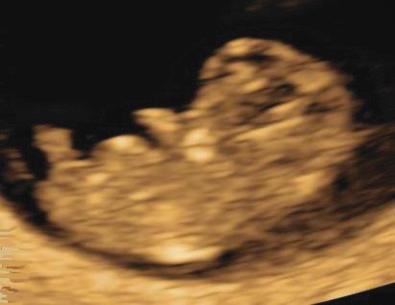
In each trimester, the face has specific characteristics ( Fig. 35.2 ). The first trimester face has a triangular shape. The orbital plane surmounted by the relatively large neurocranium forms the base and the two rami of the mandible, the sides, ending in the pointed chin. Between 16 and 36 weeks’ gestation, the facial height grows relatively more than the width, especially before 25 weeks’ gestation. In the third trimester, the face looks round because of subcutaneous fat accumulation, especially below the zygomatic bones, and because of the widening of the mandible. As opposed to the adult face, the fetal face is relatively small, which is the result of the rudimentary upper and lower jaws, the small nasal cavities and sinuses and the unerupted primary teeth.
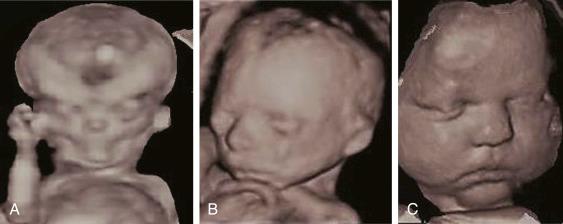
When looking at the midsagittal view, the fetal profile (FP) is concave throughout gestation as opposed to the relative flat profile in postnatal life ( Fig. 35.3 ). The concavity, mainly caused by the rather retrognathic position of the small mandible, with respect to the maxilla, is probably meant to facilitate for the newborn the concomitance of sucking movements and breathing during breast feeding.
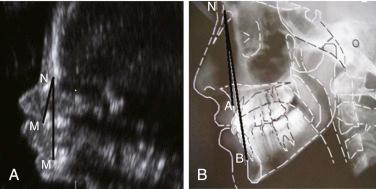
The International Society of Ultrasound in Obstetrics and Gynecology (ISUOG) has published guidelines for the routine midtrimester ultrasound scan. The recommended minimum requirements for basic midtrimester anatomical examination of the fetal face should include an attempt to visualise the upper lip for exclusion of cleft lip. If technically feasible, other facial features that can be assessed include the median facial profile and evaluation of the orbits, nose and nostrils. Many countries have developed guidelines for the routine midtrimester scan, usually recommending visualisation of the profile, eyes and lips. In a screening setting, the midsagittal (profile) plane, the coronal plane (orbits) and the anterior coronal (nose–mouth) plane are usually sufficient to visualise these structures with two-dimensional (2D) ultrasound ( Fig. 35.4 ).

A median facial profile provides important diagnostic clues for the diagnosis of cleft lip, bossing or sloping forehead, micrognathia and nasal (bone) anomalies. The coronal or axial views can be used to assess the orbits that should appear symmetrical and intact. The distance between the orbits is about the same as the diameter of one orbit. The symmetrical nose and nostrils, mouth and lips are evaluated in an anterior oblique coronal view to detect in particular cleft lip.
When anomalies are encountered at a routine scan, the pregnant woman is commonly referred to a fetal medicine unit for a more detailed ultrasound examination. In this setting, examination of the fetal face usually starts with a subjective evaluation with 2D ultrasound. A more systematic examination of the fetal face should include sagittal, axial and coronal planes. In the midsagittal plane profile view, the forehead, nasal bones, prenasal thickness, soft tissue of the nose, philtrum, tongue, palatal bone, vomer, lower lip and chin can be evaluated, and clear anomalies or dysmorphic features may be observed. The oropharynx with the uvula (equal sign) can be informative and indicate for the existence of a cleft palate. The equal sign can also be obtained in both the axial or coronal planes. In the paramedian sagittal planes the orbits, eyelids, lenses and the ears can be visualised. Of the coronal planes, the slightly tilted nose-mouth plane is the most used for evaluation of the nose (tip, alae nasi and nostrils), upper lip and mouth. More tilted views, towards the deeper structures of the face, allows for visualisation of the maxilla, palate, both eyelids, orbits with lenses and frontal bones. Serial axial images of the fetal face are particularly useful to analyse the maxilla and mandible with the tooth buds but also to view the orbits and the lenses, cheekbones, choanae, lips and tongue. A detailed facial segmental analysis is presented later in this chapter.
The use of three-dimensional (3D) ultrasound examination is the next step. This technique has been a major breakthrough in the study of the fetal face and has given rise to a new discipline called ‘fetal dysmorphology’ (see later discussion).
Suspected anomalies can be validated by objective measures of the craniofacial features at a single point in time as well serially at different gestational ages. The combination of typical facial features combined with additional findings such as associated structural anomalies affecting all organs but especially the central nervous system (CNS), poly- or oligohydramnios, fetal size, information obtained from family history and a genetic workup can lead to recognition of a known syndrome.
Three-dimensional ultrasound is especially useful in demonstrating curved structures ( Fig. 35.5 ) and surface malformations ( Fig. 35.6 ) and improves accurate topographic depiction of structures. Therefore, this technique is a major addition in the assessment of the fetal face.
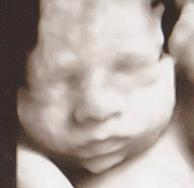
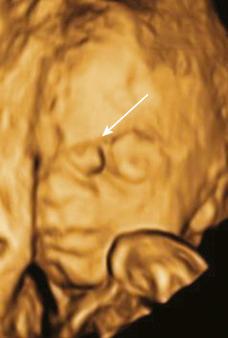
In 2D ultrasound, a single plane is imaged at a time, and the sonographer has to construct in her or his mind the complex 3D anatomy of the face. 3D ultrasound enables to collect a volume of ultrasound information consisting of multiple 2D slices. The examination starts by placing a box (region of interest) of variable size on the 2D image of the object that we want to investigate. Then a sweep is produced by a motor within the probe, whereby all the adjacent 2D slices within the box are stored. When the fetus is quiet, a slow sweep can be used, which improves spatial resolution. Ideally, there should only be amniotic fluid in front of the face and no other structures such as limbs. All stored sectional planes are integrated to form the volume. After the volume is digitally stored, the volume can be manipulated by modifying the colours and the image settings and by using different modes. These options can extract different information from the same dataset. Volumes of the fetal face are usually analysed by using cross-sectional images through the volume or by rendered images. Both approaches improve understanding of the complex anatomy of the face; cross-sectional imaging by enhancing spatial awareness and rendering imaging by facilitating a lifelike 3D view of the face (see Fig. 35.5 ).
When cross-sectional imaging is used, usually the three orthogonal planes are displayed simultaneously, named multiplanar imaging ( Fig. 35.7 ). The ultrasound volume of the fetal face can be rotated and reviewed millimetre by millimetre by scrolling through the volumes.
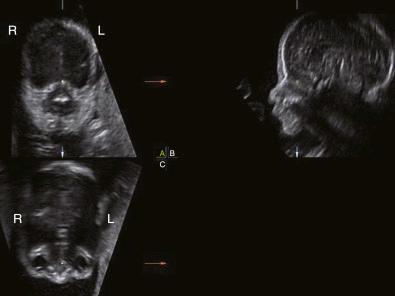
It is advisable to turn the face in the standard position with the coronal view in the upper left box, the profile view with the nose pointing to the left in the upper right box and the axial view with the nose pointing downwards in the lower left box (see Fig. 35.7 ). In this way, it is clear what is the right and left side of the fetus, and using standard positions improves subjective pattern recognition. The reference dot, which marks the intersection of the three orthogonal planes, is very helpful in identifying structures.
Multiplanar imaging is extremely helpful in defining the exact midsagittal plane. When examining the fetal profile (FP) subjectively, the true midsagittal plane is usually assumed to be present. However clear landmarks to define the exact midsagittal plane are missing. It is shown that presumed 2D profile images are significantly oblique in 30% of cases. The multiplanar imaging of 3D ultrasound provides the ultrasonographer with a unique tool: the possibility to visualise contemporarily the three orthogonal planes. A deviation from the exact midsagittal plane is easily recognised and can be corrected to the true midsagittal plane. Evaluation of the profile in an incorrect midsagittal plane can lead to diagnostic inaccuracies. For example, in a view deviating from the midsagittal plane, the most protruding part of the chin will not be visualised, creating the impression of retrognathia. Also, the forehead will suggest more bossing and the nose will seem small ( Fig. 35.8 ).
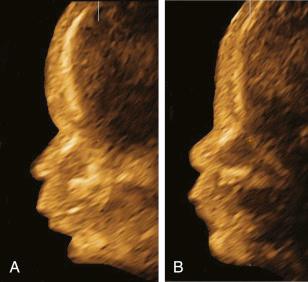
Another way to display a volume cross-sectionally is by tomographic ultrasound imaging or the ‘multislice method’. Several slices of a volume, which are parallel to each other, are simultaneously displayed with predefined number and spacing of the slices ( Fig. 35.9 ). This offers the examiner a more complete picture. The mandible and maxilla, for example, can be viewed at the same time.
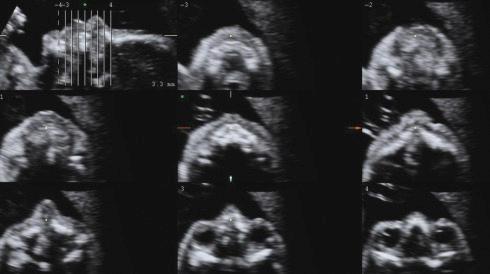
In rendering mode, the image includes information from the entire volume. The images from the three orthogonal planes are combined to obtain a realistic 3D picture (see Fig. 35.5 ). It is possible to turn and rotate the volume and view the volume from various positions. Technical options such as the electronic scalpel used to remove unwanted structures can improve the image quality and the diagnostic value of the ultrasound examinations ( Figs. 35.10 and 35.11 ).
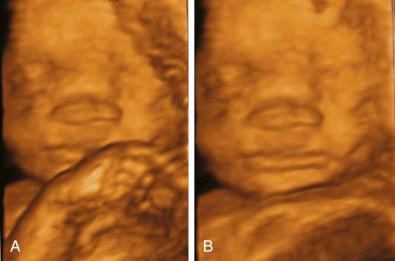
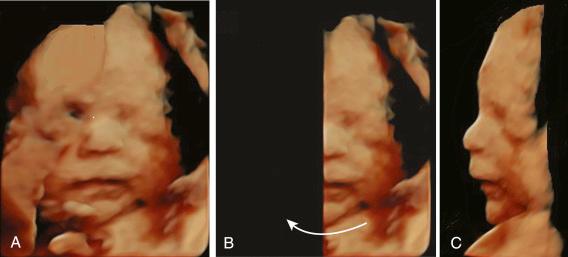
By choosing various threshold values, the rendered volume can be studied in a variety of ways. In the surface view, the outer surface of the fetus is highlighted. The fetus is displayed as a 3D sculpture. There are various technical options for editing this sculpture, for example, adjusting the gain or the position of the light or using high-definition techniques that provide skin-like pictures with sharp contrasts ( Fig. 35.12 ). By observing the fetal face in rendering mode, we will have a general subjective visual impression comparable with the ‘gestalt’ approach of clinical genetics, offering the possibility to suspect dysmorphologies, especially later in pregnancy ( Fig. 35.13 ). Rendering mode is also helpful in assessing tumours, clefts and ear anomalies. In the maximum mode, the bones are emphasised. The strongest echoes are kept, and the echoes from the soft tissue are eliminated ( Fig. 35.14 ). This especially allows visualisation of curved skeletal structures such as sutures and fontanels of the skull, hard palate and nasal bones.

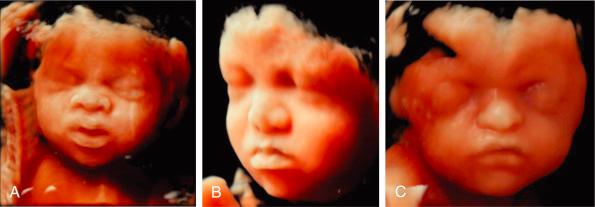
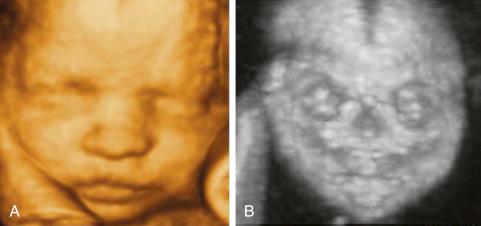
Finally, the possibility to store 3D ultrasound volumes and edit them offline facilitates communication and research. Realistic 3D images improve communication with the parents and health professionals involved in the management of the pregnancy.
Four-dimensional (4D) ultrasound added the fourth dimension ‘time’ to the 3D picture. This dramatically improved dynamic assessment of the fetal face. Movements of the mouth (yawning), tongue, eyelids and lenses can be visualised with 2D, but with 4D ultrasound, these movements can be visualised with greater ease and more details. Complex movement as seen in facial expression can be observed (see Fig. 35.12 ). 4D ultrasound might be an important modality for future prenatal behaviour studies.
Of all congenital anomalies involving the face, clefts are the most common, affecting about 1 or 2 per 1000 live births. The incidence of facial cleft varies by gender, ethnicity and geographic location, being more frequent in boys (twice as much as in girls), in Asians and in central–north Europe compared to the European average. In contrast, isolated cleft palate occurs equally often in all races (about 4 in 1000 births) and is more common in females. The distribution of clefts is estimated to be 25% for cleft lip, 50% for cleft lip and palate and 25% for isolated cleft palate.
Facial clefts may either be isolated or associated with other anomalies. The incidence of associated structural anomalies, chromosomal aberrations (mainly trisomy 13 and 18) or an underlying genetic syndrome or sequence varies with the anatomical cleft type. Therefore adequate characterisation of the cleft is important not only to counsel parent appropriately on the severity of the defect but also on its likely association with chromosomal or syndromal anomalies. Isolated clefts are associated with low mortality and morbidity rates and are primarily an aesthetic and functional problem. The percentage of isolated cases is the highest in the cleft lip (without a defect in the alveolar ridge or palate) and close to 0% in midline and atypical cleft groups. Bilateral clefts have lower percentages of isolated cases than unilateral clefts. The most frequent associated defects are musculoskeletal anomalies (polydactyly and limb reductions) followed by malformations of the CNS and malformations of the cardiovascular system. For all clefts grouped together, the reported incidence of isolated clefts varies between 31% and 71%. It should be noted that the incidence in reality may be lower because of unidentified syndromes or late manifestation of developmental delays (e.g., learning difficulties). About 350 syndromes are associated with facial clefting.
The most common syndromes and sequences identified after birth in cleft patients (including isolated cleft palate) are Pierre Robin sequence, Van der Woude syndrome, Stickler syndrome, CHARGE (coloboma, heart defects, atresia choanae, retardation of growth, genital abnormalities, and ear abnormalities) association, ectrodactyly-ectodermal dysplasia-cleft syndrome, Goldenhar syndrome, Apert syndrome, Treacher Collins syndrome, Wolf-Hirschhorn syndrome, velocardiofacial syndrome (22q11deletion), Smith-Lemli-Opitz syndrome, Fryns syndrome and oral-facial-digital syndrome.
In a small percentage of cases, facial clefts are atypical and occur in different regions of the face. According to the well-established Tessier classification, the defects are numbered from 0 to 14 and classified based on the anatomical localisation of the cleft, with the orbit as reference structure. The most common atypical facial cleft found at birth is Tessier 7, a lateral cleft between the corner of the mouth and the ear.
When there is suspicion of a fetal cleft with associated anomalies the parents should be referred for genetic counselling and additional genetic investigations. Usually a multidisciplinary team consisting of a medical specialist (fetal medicine), a plastic surgeon (ear, nose and throat) and a specialised nurse or social worker will explain the surgical options, aesthetic outcomes and specific feeding needs of a newborn with a cleft lip or palate and will take care of the psychological impact of the anomaly for the family.
The recurrence risk for isolated cases is 5% if one sibling or parent is affected and 10% if two siblings are affected. In syndromic cases, all kinds of inheritance have been described (autosomal dominant, autosomal recessive, X-linked).
In the first trimester, the following findings are clues to the presence of a facial cleft: the premaxillary protrusion ( Fig. 35.15 ), an abnormal maxilla–nasion–mandible (MNM) angle, an abnormal retronasal triangle ( Fig. 35.16A ) and the maxillary gap ( Fig. 35.15 and 35.16B ). Also, an enlarged nuchal translucency increases the risk for facial clefts.
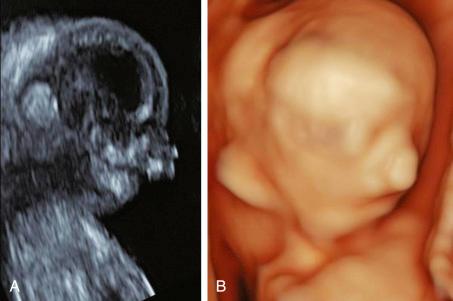
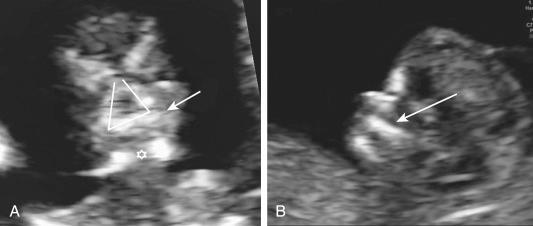
The ultrasonographic assessment usually starts by 2D ultrasound examination. The slightly tilted coronal nose–mouth view is an important and obligatory plane for the diagnosis of facial clefts. In this plane, the nostrils, philtrum and upper lip can be evaluated ( Fig. 35.17 ).

In the axial plane, the alveolar ridge and the upper lip can also be evaluated ( Fig. 35.18 ).
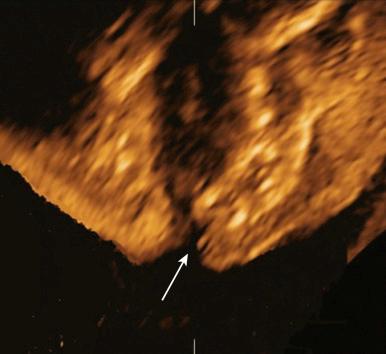
In the midsagittal plane, the premaxillary protrusion can be seen, especially in bilateral clefts, although all types of clefts show some protrusion of the premaxilla except when there is an intact alveolar ridge ( Fig. 35.19 ). The protrusion is caused by the missing restraining effect of an intact musculus orbicularis oris, and its severity can be quantified with the MNM angle (see Fig. 35.18 ). In unilateral clefts, the profile may look flat because of missing soft tissue (in front of the maxilla) and because the muscularis orbicularis oris pulls the lip to the noncleft side. ( Fig. 35.18A ).
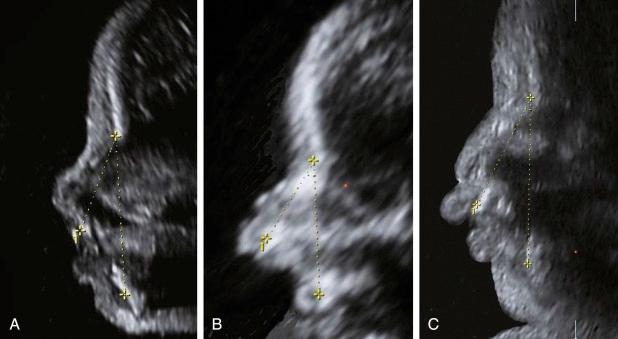
Prenatal diagnosis of a cleft palate is a challenge because of the shadows produced by surrounding osseous structures interfering with a good visualisation of the palate. When the fetal head is tilted backwards and the mouth is slightly open, the whole palate can be visualised from the hard palate to the uvula (soft palate). Care has to be taken to scan in the exact midsagittal plane ( Fig. 35.20 ).
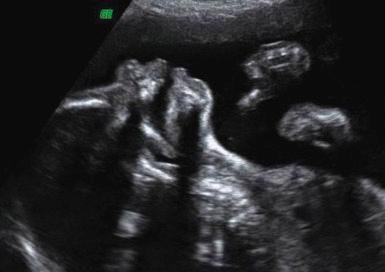
If the fetus makes breathing movement, adding colour may reveal a cleft in the palate by showing bidirectional flow of amniotic fluid over the palate.
The equal sign described by Wilhelm is an important marker for an intact uvula ( Fig. 35.21 ). It can be visualised in in all three planes, and its visualisation proves an intact palate. If the uvula cannot be visualised in its typical presentation (equal sign), there should be a strong suspicion of a cleft palate.
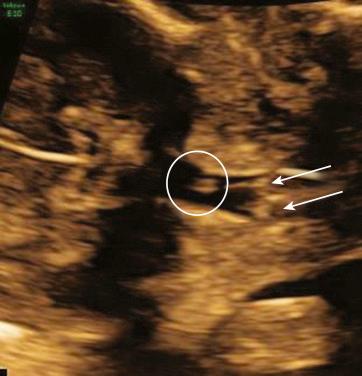
There were great expectations for the role of 3D ultrasound in the diagnosis of facial clefts, especially in the challenging diagnosis of the palate. 3D ultrasound does not seem to improve the detection rate of cleft lip and palate; however, a more precise and reliable diagnosis can be achieved. For example, rendered images of the face can show unequivocally that the upper lip is intact (see Fig. 35.5 ) or may be useful in defining the extent of the cleft(s) in the lip (complete or incomplete, uni- or bilateral) ( Fig. 35.22 ).
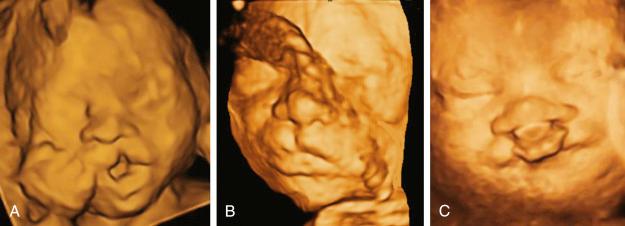
Several techniques have been proposed to improve detection of especially cleft palate.
First the ‘reverse-face’ view was introduced by Campbell. With this technique, a frontal 3D-rendered view of the face is obtained and rotated 180 degrees around the y-axis of the fetus. Then by looking from the oropharynx (from inside out), the palate, tongue, nasal cavity and orbits can be seen by scrolling through the volume ( Fig. 35.23 ).
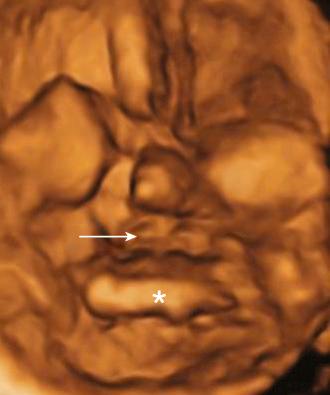
Hereafter different strategies using 3D volumes have been developed to visualise the palate; these techniques include the ‘flipped-face’ view ( Fig. 35.24 ), the ‘flipped face’ view with angled insonation, the anterior axial 3D view reconstruction and variants of these. They differ mainly in starting plane, insonation angles, the way the volume is rotated and the position of the view bar. The best images are obtained when the head of the fetus is slightly extended, the mouth is open and amniotic fluid is present in the oral cavity (see Fig. 35.20 ). In everyday practice, fetuses have very different positions, and the image quality differs in each patient. Therefore the best strategy must be considered on a case-by-case basis.
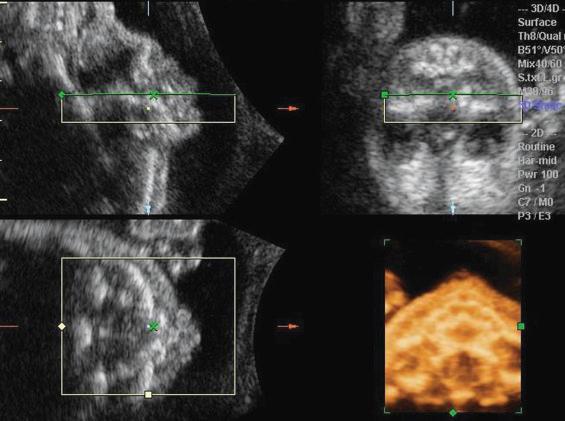
Recently, new 3D tools such as the ‘polyline’ enable tracing a line along the curved 2D sagittal view of the palate and to obtain a rendered image of it ( Fig. 35.25 ). Also in these cases, it is important that the fetus has a slightly open mouth and that the palate lies as much as possible perpendicular to the scanning plane.
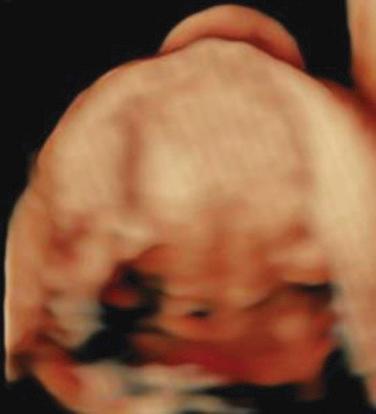
Become a Clinical Tree membership for Full access and enjoy Unlimited articles
If you are a member. Log in here